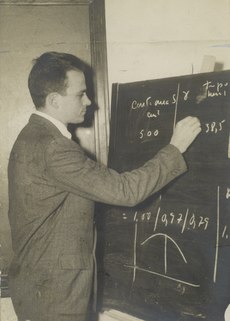César Lattes
César Lattes , actually Cesare Mansueto Giulio Lattes , (born July 11, 1924 in Curitiba , Paraná, Brazil; † March 8, 2005 in Campinas , São Paulo) was a Brazilian experimental physicist. He was a co-discoverer of the pi meson .
Lattes was born in Curitiba as the child of Italian-Jewish immigrants . He studied at the University of São Paulo , where he finished his studies in mathematics and physics in 1943. He was part of a group of young Brazilian physicists who worked with European teachers such as Gleb Wataghin (1899–1986) and Giuseppe Occhialini .
At the age of 23 he founded the Centro Brasileiro de Pesquisas Físicas in Rio de Janeiro together with a few other physicists .
From 1947 to 1948, Lattes focused on studying cosmic rays , which had been discovered by Carl David Anderson in 1932 . He set up a laboratory 5000 meters above sea level in the Bolivian Andes , in which he recorded the radiation with the help of photographic plates.
Lattes traveled to England with his teacher Occhialini to do research there at the University of Bristol under the direction of Cecil Powell . After a further development of the photographic emulsions, they succeeded in 1947 in the detection of heavy mesons (both pions and muons , which at that time were also called mesons) in cosmic radiation and the determination of their essential properties. Lattes wrote an article about this discovery for Nature magazine , with Muirhead, Occhialini, and Powell as co-authors , without Powell's consent . In the same year, Lattes calculated the mass of the newly discovered particle. A year later, Lattes was now working alongside Eugene Gardner at the University of California, Berkeley , he discovered the artificial production of pion particles when he bombarded carbon atoms with alpha particles in the cyclotron .
In 1949 Lattes returned to the Universidade Federal do Rio de Janeiro and the Centro Brasileiro de Pesquisas Físicas in Rio de Janeiro. After another two-year stay in the United States from 1955 to 1957, he returned to the University of São Paulo and took on a teaching position there.
In 1967 Lattes moved to the new Gleb Wataghin Institute of Physics at the State University of Campinas . There he became chairman of the cosmic ray department. In 1969 he and his colleagues discovered the mass of the so-called fireballs, a phenomenon that is caused by naturally occurring, high-energy collisions.
In 1986 Lattes retired after receiving the title of Dr. hc and professor emeritus . He died of a heart attack on March 8, 2005.
Although Lattes was the lead researcher and lead author of the Nature article, Powell was awarded the Nobel Prize in Physics alone in 1950 . One reason for this was that until 1960 the Nobel Prize was only awarded to the research director.
Works
- Lattes, CMG, Muirhead, H., Occhialini, GP S . & Powell, CF : Processes involving charged mesons . Nature 159 (1947) 694-697
- Lattes, CMG; Occhialini, GPS; Powell, CF: A determination of the ratio of the masses of pi-meson and mu-meson by the method of grain-counting . Proceedings of the Physical Society 61 (1948) p. 173-183
- Gardner, E .; Lattes, CMG: Production of mesons by the 184-inch Berkeley cyclotron . Science 107 (1948) p. 270-271
- Lattes, CMG; Orsini, CQ; Pacca, IG; Cruz, MT; Okuno, E .; Fujimoto, Y .; Yokoi, K .: Observation of extremely high energy nuclear events with emulsion chamber exposed on Mt. Chacaltaya . Il Nuovo Cimento, XXVIII (1963), n.3, p. 2160
Web links
| personal data | |
|---|---|
| SURNAME | Lattes, César |
| ALTERNATIVE NAMES | Lattes, Cesare Mansueto Giulio (real name) |
| BRIEF DESCRIPTION | Brazilian experimental physicist |
| DATE OF BIRTH | July 11, 1924 |
| PLACE OF BIRTH | Curitiba , Paraná, Brazil |
| DATE OF DEATH | March 8, 2005 |
| Place of death | Campinas , Sao Paulo |
